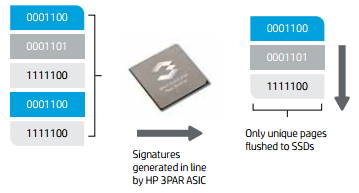HP publishes HP 3PAR OS 3.2.1 MU1 with Thin Deduplication
On October 28 2014 HP has published HP 3PAR OS 3.2.1 MU1, the first maintenance update for HP 3PAR OS 3.2.1. Beside some fixes, HP enabled in-line deduplication (Thin Deduplication) on all the systems with 3PAR GEN4 ASIC (StoreServ 7000 and 10000). Thin Deduplication does not require any license! It’s included in the base license and every customer can use it without spending money for it.
Thin Deduplication
In-line deduplication is awesome, congrats to HP for making this possible. Deduplication on primary storage is nothing new, but the way how HP 3PAR doing it, is really cool. It’s not a post-process, like NetApps deduplication technology. With HP 3PAR, deduplication happens when data enters the array. I took this figure from a HP whitepaper. It shows in a simple way what enables HP 3PAR to do in-line deduplication: The 3PAR GEN4 ASIC (Who has criticised 3PAR for using custom ASICs…?). Thin Deduplication is in line with the other 3PAR thin technologies.

Patrick Terlisten/ vcloudnine.de/ Creative Commons CC0
Ivan Iannaccone write a really good blog post on who Thin Deduplication works. I really recommend to read it! Welcome to Flash 2.0: HP 3PAR Thin Deduplication with Express Indexing
As already mentioned Thin Deplication is available on all HP 3PAR systems with GEN4 ASIC. This is currently the StoreServ 7000 and 10000 series. Even a customer with a “small” 7200 can use Thin Deduplication without additional cost. And who knows what the HP Discover will bring us… There are currently some small limitations when using Thin Deduplication. But I’m quite sure that these are only temporary.
- Thin Deduplication is currently only available for Virtual Volumes (VV) provisioned from a SSD tier.
- You can’t use TDVV with Adaptive Optimization Configuration. This is presumably because Thin Deduplication is only available for VV provisioned from a SSD tier. If a region from a TDVV has to be moved to a lower tier, the data has to be rehydrated.
- Converting from any VV to Thin Deduplication Virtual Volume (TDVV) can be accomplished with Dynamic Optimization, which is a licensable feature.
You can have up to 256 TDVV per SSD CPG. Deduplication is fully supported with 3PAR replication (sync, async), but the replicated data is not deduplicated. You can use a estimation functionality to estimate the amount of deduplicated data for TPVV. This estimation can be run online against any volumes, regardless on which tier the data reside.
Bugfixes
Beside the new Thin Deduplication feature, HP fixed some bugs in this MU. Here is an excerpt from the release notes:
- 116690 An issue in QoS and ODX from Windows hosts causes an uncontrolled shutdown.
- 117123 The version of Bash is updated to resolve the vulnerabilities CVE-2014-6271 and CVE-2014-7169 commonly known as “shellshock”
- 114947 The total capacity of the volumes in a Peer Persistence Remote Copy group is limited to 32 TB.
- 114244 Loss of host persona capabilities after upgrading to HP 3PAR OS 3.2.1 GA from HP 3PAR OS 3.1.2 MU5 or HP 3PAR OS 3.1.2 MU3 + P41.
For more details take a look into the Release Notes for HP 3PAR OS 3.2.1 GA/ MU1. If you’re interested in the basics concepts of HP 3PAR, take a look into the HP 3PAR StoreServ Storage Concepts Guide for HP 3PAR OS 3.2.1.
